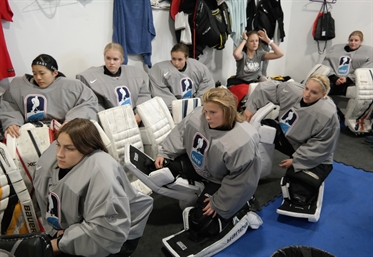Goalies came together
Goalies came together
First-ever camp in Granada a success

 Goalies at the 2017 IIHF Women’s Goaltending Development Camp listen to their goaltending coach in the dressing room. Photo: Martin Merk
Goalies at the 2017 IIHF Women’s Goaltending Development Camp listen to their goaltending coach in the dressing room. Photo: Martin Merk
The 2017 IIHF Women’s Goaltending Development Camp is the first of its kind in international ice hockey and happened on the women’s side. But why did participants, coaches and mentors from 18 countries come together at the Igloo ice rink outside of Granada in southern Spain?
The camp is the newest initiative of the IIHF Women’s Committee after the first few months of a new cycle. After having organized High-Performance Camps since 2011, it was discussed how to go forward. “We were thinking how we should do it in the future and whether changes are needed. We decided that we should focus on different positions instead of having full teams at the camps and thought the goalie position is a very important part of our game,” said IIHF Council member Zsuzsanna Kolbenheyer. “If we can improve our goalies, that would be a big help for our countries and the teams. Goalies can make a huge difference at every level.”
“For us the goalie position influences 80 per cent of the result. If you have a stable and confident goalie, you are halfway through in the game,” said IIHF Council member Marta Zawadzka talking from her own experience in the Polish women’s national team program.
“For goalies from smaller countries it’s important to improve and to show them how to improve to become a better goalie. On the Polish national team it’s definitely a very important position. We were stuck in Division IIA and we found a new star in the net within the young goalies and got promoted last year. Having stability gives your team confidence and then it can move mountains.”
Two examples of why goaltenders can be important for countries with a smaller pool of female hockey players were in Granada as mentors. Florence Schelling was a wall for Switzerland both times when the country won bronze at the 2012 IIHF Ice Hockey Women’s World Championship and at the 2014 Olympic Winter Games. Both times she was voted as best goalie of the tournament and in 2014 even as MVP. Zuzana Tomcikova was key for Slovakia in its temporary rise to the top-eight nations. Her heroics helped the underdogs win two qualification tournaments to make it to the Olympics for the first time in 2010. One year later she helped Slovakia stay in the top division with her performance, was voted MVP and All-Star goalie of the 2011 IIHF Ice Hockey Women’s World Championship. Both of them were on the ice and with the young goalies in Granada as mentors as was former Team USA goalie Brianne McLaughlin, who just retired after two NWHL seasons.
“We have two European ambassadors here with Florence Schelling and Zuzana Tomcikova and they both were the most important player on their team at events. Without them I’m pretty sure their teams wouldn’t have performed that well at the top level. We have some more good goalies in Europe but in many other countries you don’t have many at that level,” said Kolbenheyer, a long-time national team player for Hungary.
Lisa Haley echoes the observations. She has worked several years for Hockey Canada as assistant coach on the women’s national team with Olympic gold in Sochi 2014 as the biggest success and as head coach of the U18 women’s national team while being a long-time coach at the Ryerson University. She was in Granada to help organize the camp and a knowledgeable help in the organization and for the goalies.
“If you look at the game of hockey and want to make the biggest impact in the shortest amount of time, the area of improvement that matters most is the goaltending position. You’ve seen evidence of that in the last top-division Women’s World Championships with goalies like Florence [Schelling] and Zuzana [Tomcikova] with Slovakia in the net, or Noora Raty in Finland. They gave their team a good chance to win and it doesn’t matter who they’re playing. Their teams maybe don’t control the possession of the puck the same amount of time when they’re playing against Canada or the USA but if they have a strong goaltender, they give themselves an opportunity in the game. That’s why we have targeted this position specifically because we think it will help close the gap and make teams more competitive as fast as possible,” Haley said.
The Canadian has high respect from the top European goalies but also knows that the depth of good players – and good goalies – is clearly not as deep in the 16 countries from Europe and Asia present in Granada compared to North America.
“In some countries we have goaltenders that are as good and as competitive as some of the North American goalies, which is awesome to see. I mentioned the three, another example who was world-class is Kim Martin from Sweden. They are as good or better than anybody you see in North America. But who’s next? Who’s going to replace them as they come to the close of their careers? We need to find that answer and hopefully a camp like this is going to help with that,” she said.
And what was her impression after three days with the goalies and even more with the goaltending coaches who came to Granada to learn?
“The first thing that stands out for me is the eagerness of the players that are here. They’re so happy with that opportunity. It shows up on the ice, it shows up on their dryland sessions, it shows up in the classroom and video sessions. They’re sponges, they want more information, they want to learn. Every single goaltender here has left an impression to me how much they evaluate this opportunity. Our intention of this is to give them more information to what it takes to bring their game to full potential and they seem they’re ready to embrace that.
“Secondly, for the coaches from the federations who are here as well, it’s exactly the same thing. They worked long hours. We were still talking at meetings after midnight and they were back on the ice at 8am the next morning. I’ve been personally very impressed with how committed everyone is.”
“We want to show the goalies and the coaches how to do a good job, how to not only make them good on the ice but to prepare them off-ice and mentally so they can work on it all year,” Zawadzka said about the goals here for the young netminders. “They should be confident not only on the ice but in their life. They have leaders and mentors here, they hear their stories, they should believe everything is possible.”
For Kolbenheyer it was special to have both senior goaltenders and U18 goalies together. Even though they were split into two groups of each age category, they were able to watch each other.
“It's good that we have the senior and U18 goalies together so the younger goalies can see how the senior goalies are performing and what is the next level they can get if they work hard enough,” Kolbenheyer said.
The goaltending coaches are another aspect of the camp. 12 came here to learn and although all but two were men, they’re all involved in women’s hockey. Something that’s not self-evident.
“In many countries we don’t have so many goalie coaches especially on the women’s side but I’m happy that so many coaches wanted to come here and work with the players and learn more to work with the goalies who are here from their country also during the season,” Zawadzka said.
Kolbenheyer said that while there are just few goalie coaches in Hungary, they are mostly working on the men’s side. “For women’s teams it’s very tough to find good ones who can develop the young goalies,” she said.
That’s why they took one coach from their country with them to Granada. It was important to have them here because goaltenders have a different game and need different skills than skaters. Whether a goalie just learns by doing by being the shooters’ target at practice or whether they get specific training based on a more scientific approach can make the difference between a world-class goalie and an average puck stopper. But that’s a story for another day here on IIHF.com.
For Haley the camp has been a success story that she hopes will continue.
“It is a new concept. We accomplished a lot this week. We can see the improvement from the first practice to today how much the goalies have improved. If it’s possible continuing with this camp on a regular basis, I think it’s going to be a really effective tool to help all the countries to become more competitive,” she said.
Other stories & videos from the camp:
Video: Tour the goalie camp in Granada
Video: Goalies answer your questions
Video: Meet 18 goalies from 18 countries
Video: Ask goalies a question
Goalies not just a target
Why goalies came together
Passing on the torch
Suddenly in the spotlight
Goalie camp ready to start
Photo Gallery
Back to Overview







































